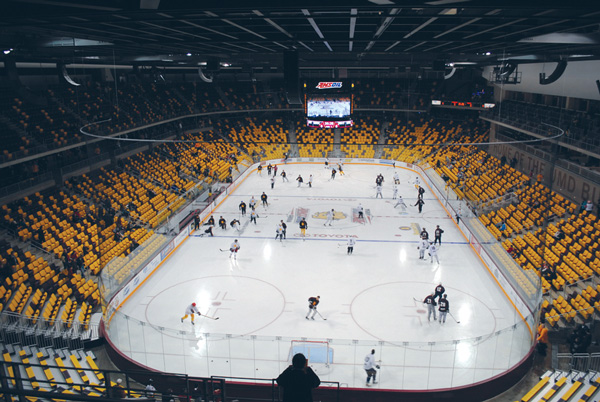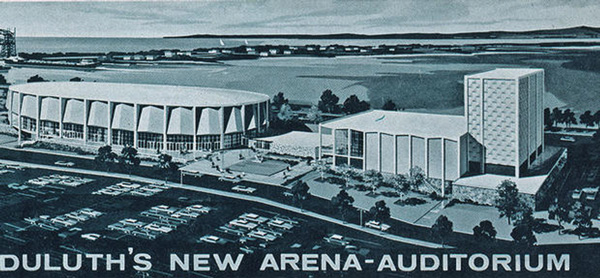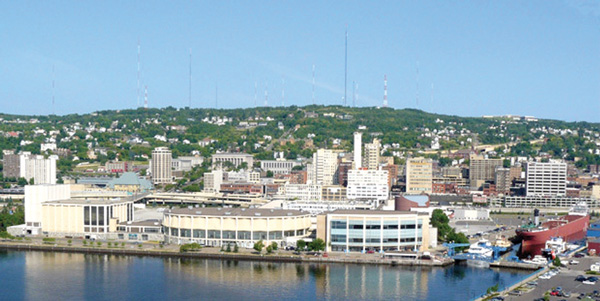Duluth Arena Helped UMD Skate Into Big Time

Can it really be 50 years ago? It must be, because media folks are scurrying around trying to coax reminiscences out of former hockey stars who might go back far enough to remember when the UMD Bulldogs made their grand entrance into big time college hockey by playing in the sparkling, new Duluth Arena.
One of the beautiful things about getting old enough is that some of those memories remain indelibly embedded for the long haul.
As a young reporter starting out on a sports-writing career at the Duluth News-Tribune, it was my pleasure to already be assigned to cover hockey. Bruce Bennett, our sports editor, had already found a willing foil for his small staff, because the previous season I had spread myself thin covering UMD hockey as well as every available high school game at the Curling Club, which was on 13th Avenue East and London Road.
The Curling Club was a fabulous building. A castle, really, made of stone and concrete. You walked into the grand entryway, and you could go straight in and find the best and busiest curling facility in all of Minnesota. But if you walked up the massive and curling stairway, you got to the upstairs level, which opened with a lobby that featured crackling radiators fighting to supply some semblance of warmth near the busy concession stand. Open the swinging doors, and the sauna-like heat instantly was transformed into bone-chilling cold. There was an ice sheet in there, surrounded entirely by a steep grandstand. The rink was short, with natural ice that didn’t need much coaxing to stay hard. The first row of stands meant if anyone got checked into the boards, your knees were threatened.
But the hockey was great. Always. Ralph Romano, guiding UMD out of the MIAC to the stepping stone of independent status, on the way to entry to the prestigious WCHA, had brought together the best high school players from the Twin Ports and the Iron Range, plus the top players from Fort William, Port Arthur, Fort Frances, and Winnipeg. The Bulldogs played hard and threw a challenge at such storied rivals as Minnesota, North Dakota, Michigan Tech, Denver, Michigan State and Colorado College.
All the while, the process foreseen by Romano, who was both coach and athletic director, under president Raymond Darland, included the proposed construction of a new facility. It was called the Duluth Arena-Auditorium, and it was the bargain of the century, costing $6.1 million for a hockey arena, plus a fantastic symphony and concert hall, and three gigantic convention meeting rooms downstairs.
And it was built right down at harborside. You could walk around the glassed-in outer concourse between periods of a hockey game, and you could look out at the Aerial Bridge, and the chilly waters of the harbor were no more than 50 feet from you, across one narrow street and a sidewalk.

It was finished and ready for the fall of 1966. Joe Sturckler was the manager of the place, and it was, without question, the finest college hockey arena in the nation. There was nothing like it in the WCHA, where Minnesota played in an old quonset named Williams Arena, North Dakota played in a frigid facility that had one distinct advantage over not being outdoors – no windchill. Michigan Tech played in Dee Stadium, a quaint little building down on the riverfront. Denver had an old arena too, and Colorado College played in the Broadmoor World Arena, an ancient place that could never quite live up to the grandeur of its name. Michigan State was also in an old place, as was Michigan.
And here came upstart UMD, which had finished eighth and lasst at 7-19-2 in its first year in the WCHA, and last year in the Curling Club, with a new arena that had the best sightlines and the most spontaneous energy of any arena in the country.
The season was to open with a WCHA game against Minnesota – already UMD’s arch-rival. The Gophers knew what to expect, and that would be the run-around from pint-sized Bulldog centerman Keith (Huffer) Christiansen, who had already proven capable of magical stickwork that could mesmerize foes, an instant before a deft pass or shot that would produce UMD goals.
There were other players, of course, and some were exceptional. But this was Huffer’s team. The Gophers had high hopes, as always, and the place was jammed for the battle that would christen the Duluth Arena.
Most of the details of the game have blurred into memory, except for one recurring one: Huffer Christiansen would stickhandle at lightning quickness, and dash and dart into the Gopher zone, then veer off, toward a corner. One, two, sometimes three and even four Gophers, all wearing those odd little Spam-can-like helmets, would chase after him. As the game wore on, the chase got more intense. We might have worried for his well-being, but that was unnecessary.
When the game ended, Huffer Christiansen had six assists, and UMD had blitzed Minnesota 8-1. It was hockey’s version of the Pied Piper, how he could lead that bad guys away from the goal, then zip a pass to the crease where a teammates would find easy picking against a defenseless goaltender. It might have been Mike Tok scoring the goal, or Pat Francisco, or Bruce McLeod, but always somebody who was smart enough to get open in scoring position, knowing Huffer would put the puck on their stickblade.
Christiansen played in 102 games for UMD, a 5-foot-6 dynamo who looked pudgy, mainly because he wore his hockey breezers pulled up as far as they could go in case some unruly foes decided that a well-placed spear might slow him down. He scored 75 goals, 121 assists, for 196 points in those games, and he had 95 penalties called against him by those officials who spotted why it was that those foes wanted to spear him.
UMD kept records of the leading scorers of 11 teams that played before Christiansen came down from Fort Frances, Ontario – he had made a few forays across the Rainy River to play on the Minnesota state championship International Falls team in 1961-62 – but once he arrived at UMD, the scene shifted. In the 1963-64 season, Christiansen had 16-20--36 in 25 games; the next year he had 23-35--58 in 27 games; in his third season, he had 13-27--40 in 28 games; and in 1966-67, he had 23-39–62 in 28 games.
In all four of those seasons, he was UMD’s leading scorer. But the season best remembered was his final one, 1966-67, when he won the WCHA scoring title, was All-American, and was named the Outstanding Player in the WCHA. But most importantly, that was the season that UMD moved into the “House That Huffer Built.”
There will be all sorts of recollections this week about big games in the arena that later was renamed the “Duluth Education and Convention Center” – the DECC – but the first official game in the Duluth Arena was as big as they get. You had to be there.

